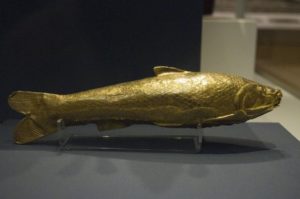
How is the jewelry you wear and the iPhone you use connected with contaminated fish you may find on your plate?
The answer is gold.
Artisanal, small-scale gold mining is the leading cause of mercury pollution in the world, accounting for over 30% of global emissions. About 10% to 25% of the world’s total gold supply comes from artisanal gold mining.
Over the past decade, the price of gold has been increasing, reaching as high as US$1,828.50 an ounce in 2011. This has lead to a gold rush of sorts in poor communities around the world, where artisanal, small-scale gold mining provides a valuable source of income.
Millions of men, women and even children toil in mines using toxic mercury to extract tiny pieces of gold that would otherwise be too small to recover. Mercury that is released escapes into the atmosphere and travels, dropping into oceans and rivers, poisoning seafood worldwide.
Now if mercury released thousands of miles away can affect us here in the U.S., imagine the damage it does to the miners and their families? There are around 4.5 million women and 600,000 children among some 15 million artisanal gold miners around the world. It is a dangerous job.
Today, an estimated 19 million people are at risk of mercury poisoning worldwide.
What is being done?
On a global level, efforts are underway to address the problem with the Minamata Convention on Mercury entering into force.
On the ground, Pure Earth has been working to clean up and prevent toxic mercury pollution in artisanal gold mining communities in Indonesia, Peru, Mongolia and many other countries. Pure Earth works to raise awareness among miners and their families about dangers of mercury, train miners in mercury-free techniques, and partners with local governments to scale up sustainable mining practices.
To date, Pure Earth’s Global Mercury Program has:
- trained nearly 2000 artisanal gold miners worldwide to go mercury-free;
- educated over 2,500 miners, community members (including children), health workers and government stakeholders about the dangers of mercury;
- restored 3.5 hectares of rainforest stripped by gold mining;
- identified and assed over 400 mercury-contaminated sites worldwide.
Learn more:
- Pure Earth’s Global Mercury Program: Success By The Numbers
- In Photos: Teaching Artisanal Gold Miners To Go Mercury Free
- Mercury Falling: See How Pure Earth Works with Filipino Miner Leoncio Na-Oy to Teach a Century-Old Mercury Free Method to Artisanal Miners Worldwide
- A Mother’s Story: Mongolian “Gold Ninja” Goes Mercury Free For Her Children
- Jewelry Industry Fights Against Toxic Gold
- Factsheet- The Toxic Toll of Mercury – Facts, Figures and the Future of “Dancing Cat Fever” Disease
- Rainforest Reforestation Brings Degraded Mining Sites Back to Life, Provide Models of Hope
- Restoring Rainforest Stripped By Gold Mining in the Amazon



